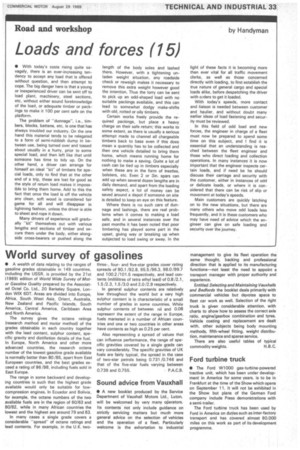Loads and forces (15)
Page 35

If you've noticed an error in this article please click here to report it so we can fix it.
• With today's costs rising quite savagely, there is an ever-increasing tendency to accept any load that is offered without question, and then attempt to cope. The big danger here is that a young or inexperienced driver can be sent off to load plant, machinery, steel sections, etc, without either sound foreknowledge of the load, or adequate timber or packings to make it 100 per cent safe on the platform.
The problem of "dunnage". i.e., timbers, blocks, battens. etc, is one that has always troubled our industry. On the one hand this material tends to he relegated to a form of semi-rubbish dump in between use, being turned over and tossed about usually in a hurry, prior to some special load, and then left like that until someone has time to tidy up. On the other hand, a driver can arrange for himself an ideal "kit" of timbers for special loads, only to find that at the other end of a trip, these are lost for good as the style of return load makes it impossible to bring them home. Add to this the fact that once the load is off the vehicle any clean, soft wood is considered fair game for all and will disappear in lightning fashion, unless the driver is able to sheet and rope it down.
Many drivers of experience will gradually "kit" themselves out with various lengths and sections of timber and secure them under the body, either alongside cross-bearers or pushed along the length of the body soles and lashed there. However, with a tightening unladen weight situation, any roadside check or reweigh makes it necessary to remove this extra weight however good the intention. Thus the lorry can be sent to pick up an odd-shaped load with no suitable packings available, and this can lead to somewhat dodgy make-shifts with old, rotted or oily timbers.
Certain works freely provide the required packings, but place a heavy charge on their safe return; this works to some extent, as there is usually a serious attempt made to channel all chargeable timbers back to base even if this does mean a quantity has to be collected and then one vehicle detailed to bring them home, which means running home for nothing to make a saving. Quite a lot of cash can be tied up in timbers especially when these are in the form of trestles, bolsters, etc. Even 2 or 3in. spars can add up when several dozen lengths are in daily demand, and apart from the loading safety aspect, a lot of money can be saved around a depot if someone on site is detailed to keep an eye on this feature.
Where there is no such care of dunnage and lashings, there are real problems when it comes to making a load safe, and in several instances over the past months it has been noted that poor timbering has played some part in the upset, giving way or breaking up when subjected to load swing or sway. In the light of these facts it is becoming more than ever vital for all traffic movement clerks, as well as those concerned directly with loading, to first establish the true nature of general cargo and special loads alike, before despatching the driver with orders to get it loaded.
With today's speeds, more contact and liaison is needed between customer and haulier, and without doubt many earlier ideas of load fastening and security must be reviewed.
In this field of odd load and new forces, the engineer in charge of a fleet must now be prepared to spend some time on this subject, and I find it is essential that an understanding is reached between the fleet engineer and those who direct loading and collection operations. In many instances it is now important that the engineer inspects certain loads, and if need be he should discuss their carriage and security with the customer, either in instances of odd or delicate loads, or where it is considered that there can be risk of slip or movement at today's speeds.
Main customers are quickly latching on to the new situations, but there are many others who move odd loads less frequently, and it is these customers who may have need of advice which the engineer can give on safe loading and security over the journey.




































































































